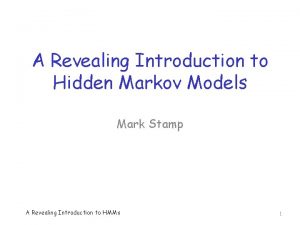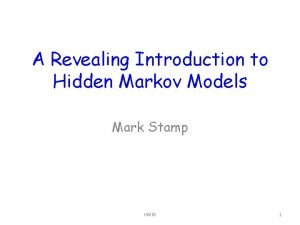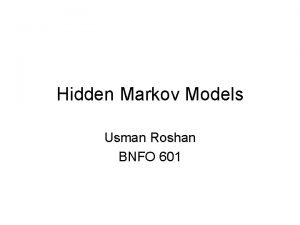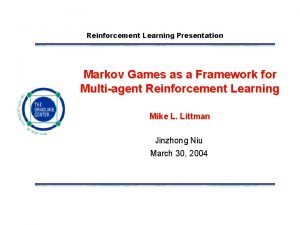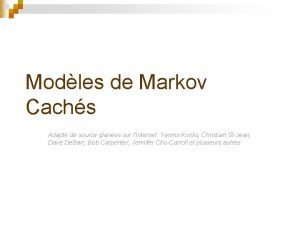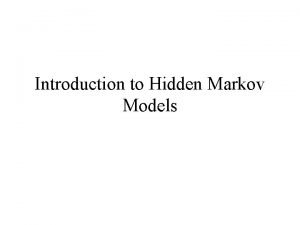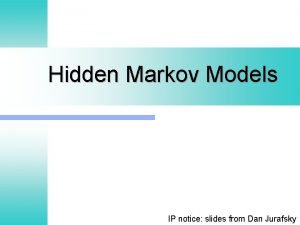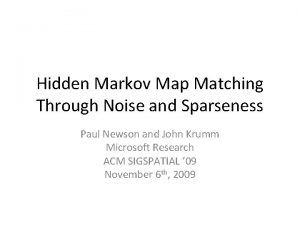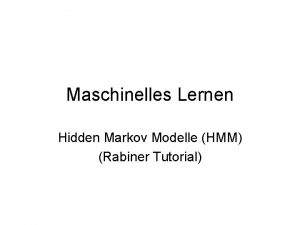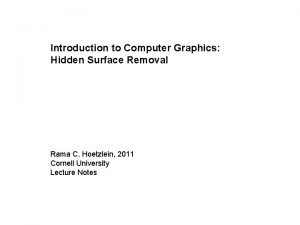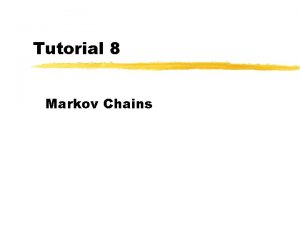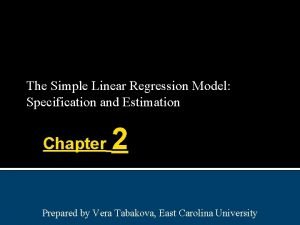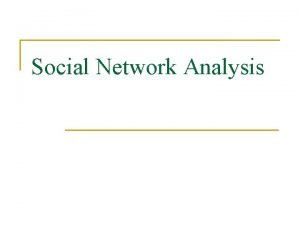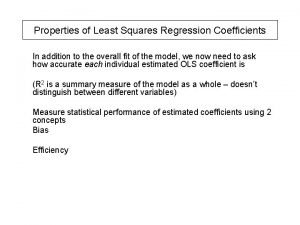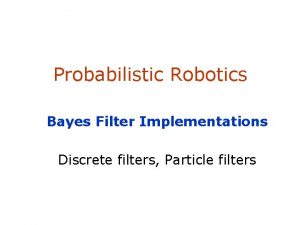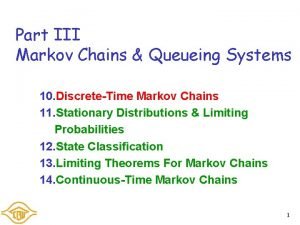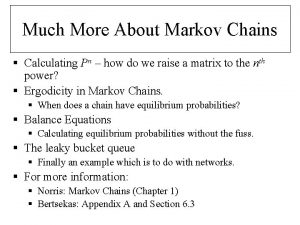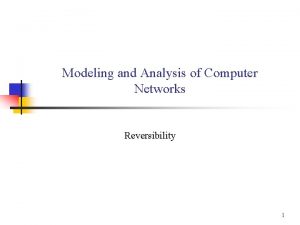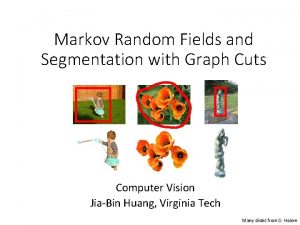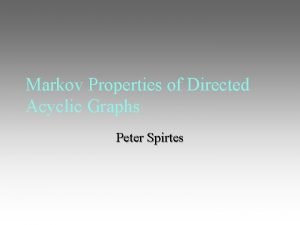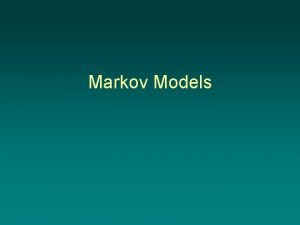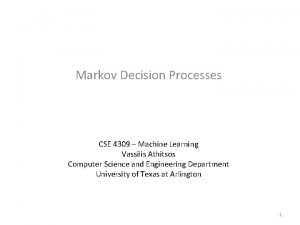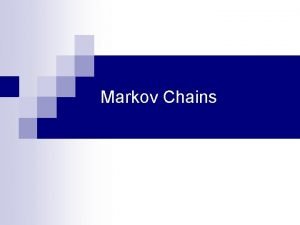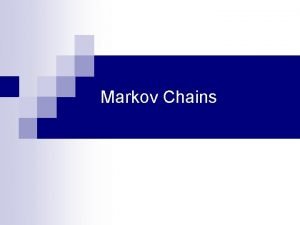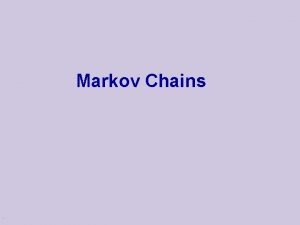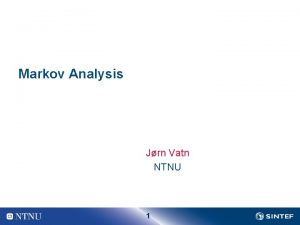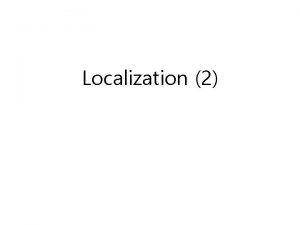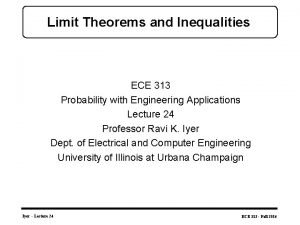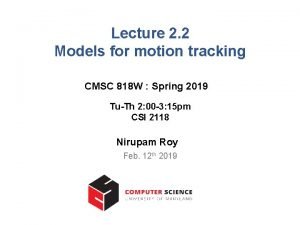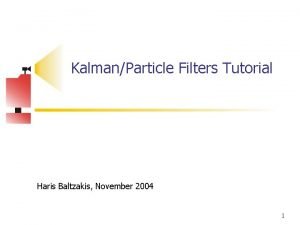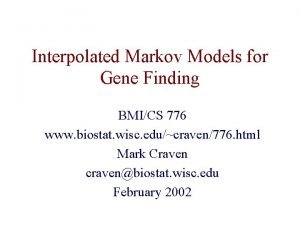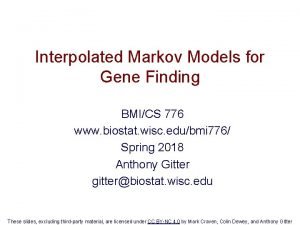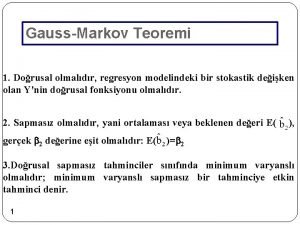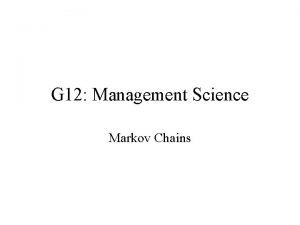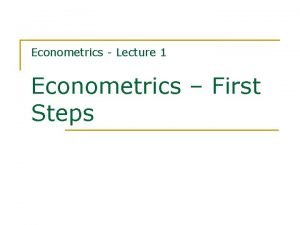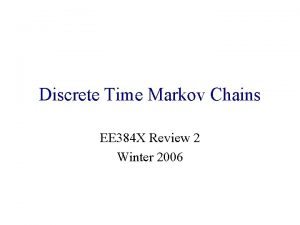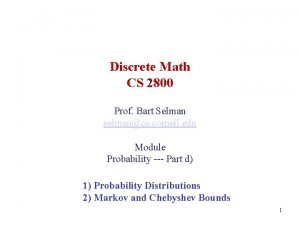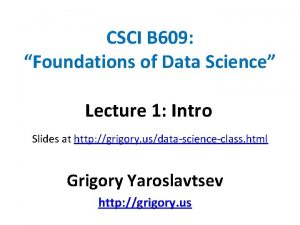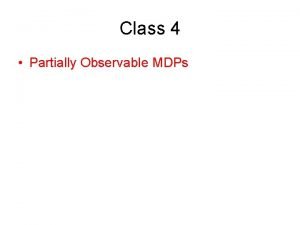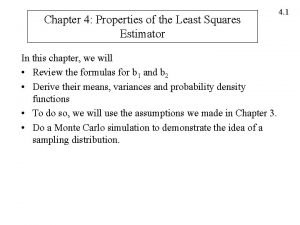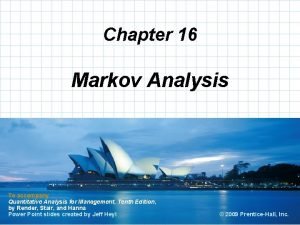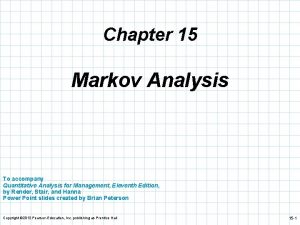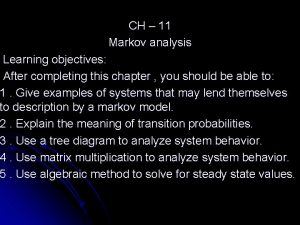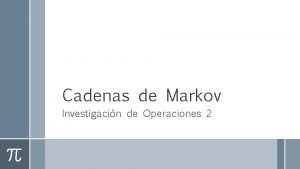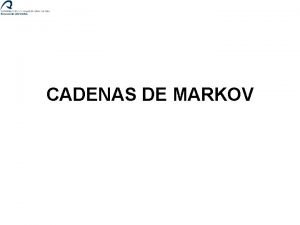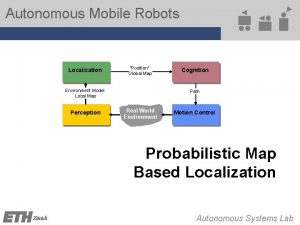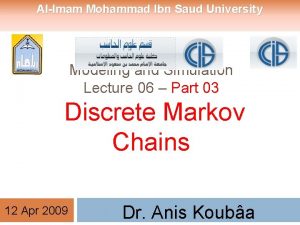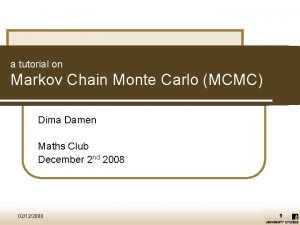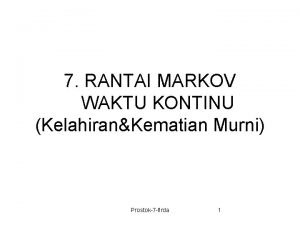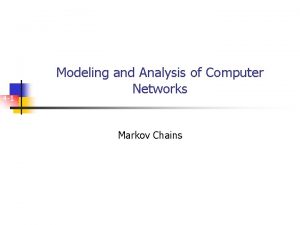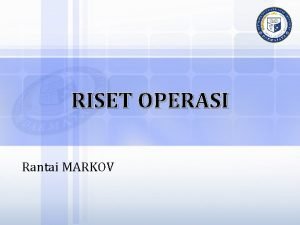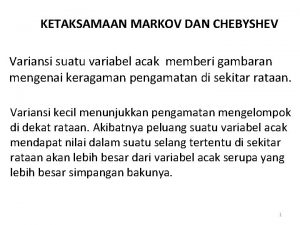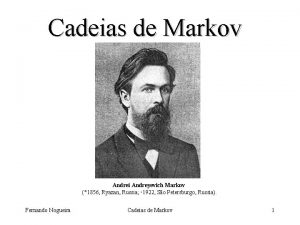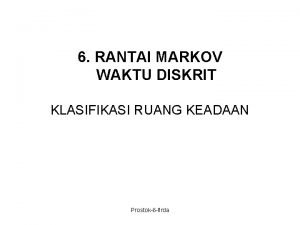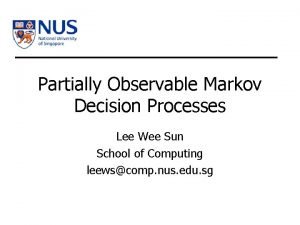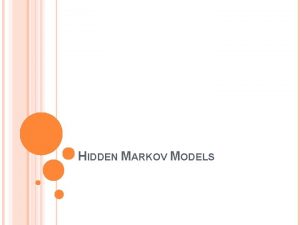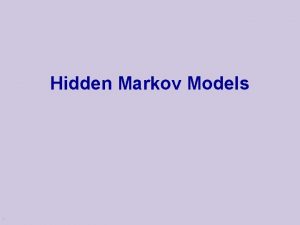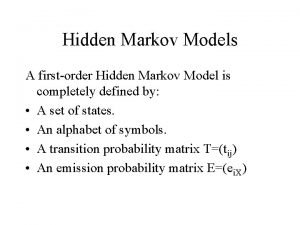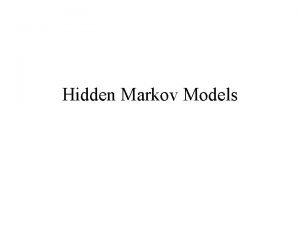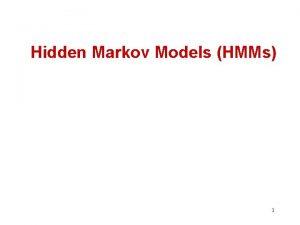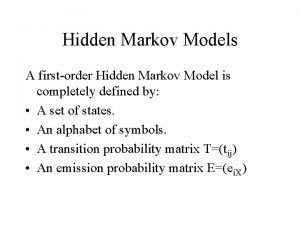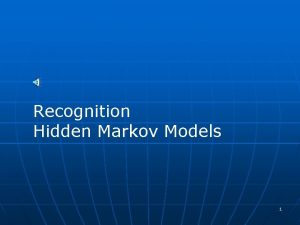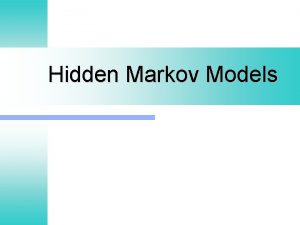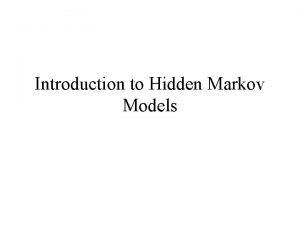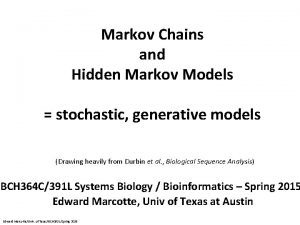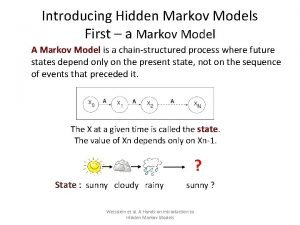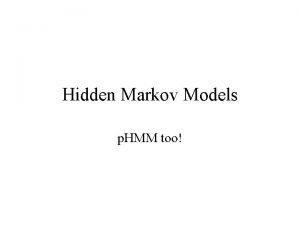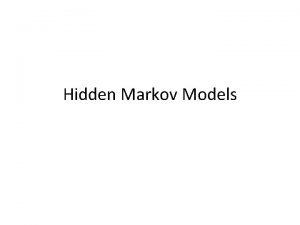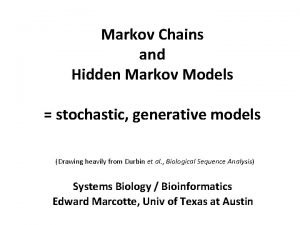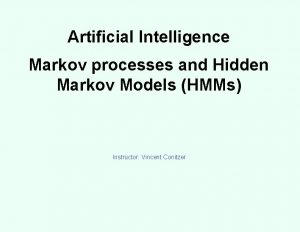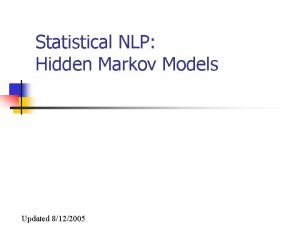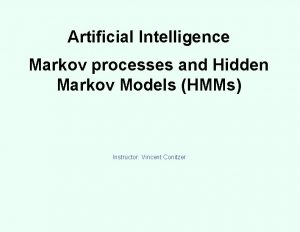A Revealing Introduction to Hidden Markov Models Mark







































































- Slides: 71

A Revealing Introduction to Hidden Markov Models Mark Stamp HMM 1

Hidden Markov Models q What is a hidden Markov model (HMM)? u. A machine learning technique u A discrete hill climb technique q Where are HMMs used? u Speech recognition u Malware detection, IDS, etc. q Why is it useful? u Efficient algorithms HMM 2

Markov Chain q Markov chain is a “memoryless random process” q Transitions depend only on u current state and u transition probabilities matrix q Example on next slide… HMM 3

Markov Chain 0. 7 q We are interested in average annual temperature u Only consider Hot and Cold q From recorded history, we obtain probabilities u See H diagram to the right 0. 4 0. 3 C 0. 6 HMM 4

Markov Chain q Transition matrix 0. 7 probability H 0. 4 0. 3 q Matrix q Note, is denoted as A A is “row stochastic” HMM C 0. 6 5

Markov Chain Can also include begin, end states q Begin state matrix is π 0. 7 q u q In this example, 0. 6 0. 4 0. 3 begin Note that π is row stochastic H 0. 4 end C 0. 6 HMM 6

Hidden Markov Model q HMM u But includes a Markov chain this Markov process is “hidden” q Cannot observe the Markov process u Instead, we observe something related to hidden states u It’s as if there is a “curtain” between Markov chain and observations q Example on next slide HMM 7

HMM Example q Consider H/C temperature example q Suppose we want to know H or C temperature in distant past u Before humans (or thermometers) invented u OK if we can just decide Hot versus Cold q We assume transition between Hot and Cold years is same as today u That is, the A matrix is same as today HMM 8

HMM Example q Temp in past determined by Markov process q But, we cannot observe temperature in past q Instead, we note that tree ring size is related to temperature u Look at historical data to see the connection q We u consider 3 tree ring sizes Small, Medium, Large (S, M, L, respectively) q Measure tree ring sizes and recorded temperatures to determine relationship HMM 9

HMM Example q We find that tree ring sizes and temperature related by q This is known as the B matrix: q Note that B also row stochastic HMM 10

HMM Example q Can we now find temps in distant past? q We cannot measure (observe) temp q But we can measure tree ring sizes… q …and tree ring sizes related to temp u By the B matrix q So, we ought to be able to say something about temperature HMM 11

HMM Notation q. A lot of notation is required u Notation may be the most difficult part HMM 12

HMM Notation q To simplify notation, observations are taken from the set {0, 1, …, M-1} q That is, q The matrix A = {aij} is N x N, where u q The matrix B = {bj(k)} is N x M, where u HMM 13

HMM Example q Consider our temperature example… q What are the observations? u V = {0, 1, 2}, which corresponds to S, M, L u Q = {H, C} q What are states of Markov process? are A, B, π, and T? A, B, π on previous slides u T is number of tree rings measured u q What u are N and M? N = 2 and M = 3 HMM 14

Generic HMM q Generic view of HMM q HMM defined by A, B, and π q We denote HMM “model” as λ = (A, B, π) HMM 15

HMM Example q Suppose that we observe tree ring sizes For 4 year period of interest: S, M, S, L u Then = (0, 1, 0, 2) u q Most u likely (hidden) state sequence? We want most likely X = (x 0, x 1, x 2, x 3) q Let πx 0 be prob. of starting in state x 0 q Note prob. of initial observation u And ax 0, x 1 is prob. of transition x 0 to x 1 q And so on… HMM 16

HMM Example q Bottom line? q We can compute P(X) for any X q For X = (x 0, x 1, x 2, x 3) we have q Suppose we observe (0, 1, 0, 2), then what is probability of, say, HHCC? q Plug into formula above to find HMM 17

HMM Example q Do same for all 4 -state sequences q We find… q The winner is? u CCCH q Not so fast my friend… HMM 18

HMM Example q The path CCCH scores the highest q In dynamic programming (DP), we find highest scoring path q But, HMM maximizes expected number of correct states u Sometimes called “EM algorithm” u For “Expectation Maximization” q How does HMM work in this example? HMM 19

HMM Example q For first position… u Sum probabilities for all paths that have H in 1 st position, compare to sum of probs for paths with C in 1 st position --- biggest wins q Repeat for each position and we find: HMM 20

HMM Example q So, HMM solution gives us CHCH q While dynamic program solution is CCCH q Which solution is better? q Neither!!! Why is that? u Different definitions of “best” HMM 21

HMM Paradox? q HMM maximizes expected number of correct states u Whereas q Possible DP chooses “best” overall path for HMM to choose “path” that is impossible u Could q Cannot be a transition probability of 0 get impossible path with DP q Is this a flaw with HMM? u No, it’s a feature… HMM 22

The Three Problems q HMMs used to solve 3 problems q Problem 1: Given a model λ = (A, B, π) and observation sequence O, find P(O|λ) u That is, we score an observation sequence to see how well it fits the given model q Problem 2: Given λ = (A, B, π) and O, find an optimal state sequence u Uncover hidden part (as in previous example) u That is, train a model to fit the observations q Problem 3: Given O, N, and M, find the model λ that maximizes probability of O HMM 23

HMMs in Practice q Typically, HMMs used as follows q Given an observation sequence q Assume a hidden Markov process exists q Train a model based on observations u Problem q Then 3 (determine N by trial and error) given a sequence of observations, score it vs model from previous step u Problem 1 (high score implies it’s similar to training data) HMM 24

HMMs in Practice q Previous slide gives sense in which HMM is a “machine learning” technique u We do not need to specify anything except the parameter N u And “best” N found by trial and error q That is, we don’t have to think too much u Just train HMM and then use it u Best of all, efficient algorithms for HMMs HMM 25

The Three Solutions q We give detailed solutions to the three problems q Note: We must have efficient solutions q Recall the three problems: Problem 1: Score an observation sequence versus a given model u Problem 2: Given a model, “uncover” hidden part u Problem 3: Given an observation sequence, train a model u HMM 26

Solution 1 q Score u observations versus a given model Given model λ = (A, B, π) and observation sequence O=(O 0, O 1, …, OT-1), find P(O|λ) q Denote hidden states as X = (x 0, x 1, . . . , x. T-1) q Then from definition of B, P(O|X, λ)=bx 0(O 0) bx 1(O 1) … bx. T-1(OT-1) q And from definition of A and π, P(X|λ)=πx 0 ax 0, x 1 ax 1, x 2 … ax. T-2, x. T-1 HMM 27

Solution 1 q Elementary conditional probability fact: P(O, X|λ) = P(O|X, λ) P(X|λ) q Sum over all possible state sequences X, P(O|λ) = Σ P(O, X|λ) = Σ P(O|X, λ) P(X|λ) = Σπx 0 bx 0(O 0)ax 0, x 1 bx 1(O 1)…ax. T-2, x. T-1 bx. T-1(OT-1) q This “works” but way too costly q Requires about 2 TNT multiplications u Why? q There better be a better way… HMM 28

Forward Algorithm q Instead u of brute force: forward algorithm Or “alpha pass” q For t = 0, 1, …, T-1 and i=0, 1, …, N-1, let αt(i) = P(O 0, O 1, …, Ot, xt=qi|λ) q Probability of “partial sum” to t, and Markov process is in state qi at step t u What the? q Can be computed recursively, efficiently HMM 29

Forward Algorithm q Let α 0(i) = πibi(O 0) for i = 0, 1, …, N-1 q For t = 1, 2, …, T-1 and i=0, 1, …, N-1, let αt(i) = u (Σαt-1(j)aji)bi(Ot) Where the sum is from j = 0 to N-1 q From definition of αt(i) we see P(O|λ) = ΣαT-1(i) u Where the sum is from i = 0 to N-1 q Note this requires only N 2 T multiplications HMM 30

Solution 2 q Given a model, find “most likely” hidden states: Given λ = (A, B, π) and O, find an optimal state sequence Recall that optimal means “maximize expected number of correct states” u In contrast, DP finds best scoring path u q For u q. A u temp/tree ring example, solved this But hopelessly inefficient approach better way: backward algorithm Or “beta pass” HMM 31

Backward Algorithm q For t = 0, 1, …, T-1 and i=0, 1, …, N-1, let βt(i) = P(Ot+1, Ot+2, …, OT-1|xt=qi, λ) q Probability of partial sum from t to end and Markov process in state qi at step t q Analogous to the forward algorithm q As with forward algorithm, this can be computed recursively and efficiently HMM 32

Backward Algorithm q Let βT-1(i) = 1 for i = 0, 1, …, N-1 q For t = T-2, T-3, …, 1 and i=0, 1, …, N-1, let βt(i) = Σai, jbj(Ot+1)βt+1(j) u Where the sum is from j = 0 to N-1 HMM 33

Solution 2 q For t = 1, 2, …, T-1 and i=0, 1, …, N-1 define γt(i) = P(xt=qi|O, λ) u Most likely state at t is qi that maximizes γt(i) q Note u that γt(i) = αt(i)βt(i)/P(O|λ) And recall P(O|λ) = ΣαT-1(i) q The bottom line? Forward algorithm solves Problem 1 u Forward/backward algorithms solve Problem 2 u HMM 34

Solution 3 q Train a model: Given O, N, and M, find λ that maximizes probability of O q Here, we iteratively adjust λ = (A, B, π) to better fit the given observations O u The size of matrices are fixed (N and M) u But elements of matrices can change q It is amazing that this works! u And even more amazing that it’s efficient HMM 35

Solution 3 q For t=0, 1, …, T-2 and i, j in {0, 1, …, N-1}, define “di-gammas” as γt(i, j) = P(xt=qi, xt+1=qj|O, λ) q Note γt(i, j) is prob of being in state qi at time t and transiting to state qj at t+1 q Then γt(i, j) = αt(i)aijbj(Ot+1)βt+1(j)/P(O|λ) q And γt(i) = Σγt(i, j) u Where sum is from j = 0 to N – 1 HMM 36

Model Re-estimation q Given di-gammas and gammas… q For i = 0, 1, …, N-1 let πi = γ 0(i) q For i = 0, 1, …, N-1 and j = 0, 1, …, N-1 aij = Σγt(i, j)/Σγt(i) u Where both sums are from t = 0 to T-2 q For j = 0, 1, …, N-1 and k = 0, 1, …, M-1 bj(k) = Σγt(j)/Σγt(j) u Both sums from t = 0 to T-2 but only t for which Ot = k are counted in numerator q Why does this work? HMM 37

Solution 3 q To 1. 2. 3. 4. summarize… Initialize λ = (A, B, π) Compute αt(i), βt(i), γt(i, j), γt(i) Re-estimate the model λ = (A, B, π) If P(O|λ) increases, goto 2 HMM 38

Solution 3 q Some fine points… q Model initialization If we have a good guess for λ = (A, B, π) then we can use it for initialization u If not, let πi ≈ 1/N, ai, j ≈ 1/N, bj(k) ≈ 1/M u Subject to row stochastic conditions u Note: Do not initialize to uniform values u q Stopping conditions Stop after some number of iterations u Stop if increase in P(O|λ) is “small” u HMM 39

HMM as Discrete Hill Climb q Algorithm on previous slides shows that HMM is a “discrete hill climb” q HMM consists of discrete parameters u Specifically, the elements of the matrices q And re-estimation process improves model by modifying parameters u So, process “climbs” toward improved model u This happens in a high-dimensional space HMM 40

Dynamic Programming q Brief detour… q For λ = (A, B, π) as above, it’s easy to define a dynamic program (DP) q Executive summary: u DP is forward algorithm, with “sum” replaced by “max” q Precise details on next slides HMM 41

Dynamic Programming q Let δ 0(i) = πi bi(O 0) for i=0, 1, …, N-1 q For t=1, 2, …, T-1 and i=0, 1, …, N-1 compute δt(i) = max (δt-1(j)aji)bi(Ot) u Where the max is over j in {0, 1, …, N-1} u Not the best path, for that, see next slide q Note that at each t, the DP computes best path for each state, up to that point q So, probability of best path is max δT-1(j) q This max only gives best probability HMM 42

Dynamic Programming q To determine optimal path u While computing optimal path, keep track of pointers to previous state u When finished, construct optimal path by tracing back points q For example, consider temp example q Probabilities for path of length 1: q These are the only “paths” of length 1 HMM 43

Dynamic Programming q Probabilities for each path of length 2 q Best path of length 2 ending with H is CH q Best path of length 2 ending with C is CC HMM 44

Dynamic Program q Continuing, we compute best path ending at H and C at each step q And save pointers --- why? HMM 45

Dynamic Program q Best final score is. 002822 u And, q But u. A thanks to pointers, best path is CCCH what about underflow? serious problem in bigger cases HMM 46

Underflow Resistant DP q Common trick to prevent underflow u Instead of multiplying probabilities… u …we add logarithms of probabilities q Why does this work? u Because log(xy) = log x + log y u And adding logs does not tend to 0 q Note that we must avoid 0 probabilities HMM 47

Underflow Resistant DP q Underflow resistant DP algorithm: q Let δ 0(i) = log(πi bi(O 0)) for i=0, 1, …, N-1 q For t=1, 2, …, T-1 and i=0, 1, …, N-1 compute δt(i) = max (δt-1(j) + log(aji) + log(bi(Ot))) u Where the max is over j in {0, 1, …, N-1} q And score of best path is max δT-1(j) q As before, must also keep track of paths HMM 48

HMM Scaling q Trickier to prevent underflow in HMM q We consider solution 3 u Since q Recall it includes solutions 1 and 2 for t = 1, 2, …, T-1, i=0, 1, …, N-1, αt(i) = (Σαt-1(j)aj, i)bi(Ot) q The idea is to normalize alphas so that they sum to one u Algorithm on next slide HMM 49

HMM Scaling q Given αt(i) = (Σαt-1(j)aj, i)bi(Ot) q Let a 0(i) = α 0(i) for i=0, 1, …, N-1 q Let c 0 = 1/Σa 0(j) q For i = 0, 1, …, N-1, let a 0(i) = c 0 a 0(i) q This takes care of t = 0 case q Algorithm continued on next slide… HMM 50

HMM Scaling q For q t = 1, 2, …, T-1 do the following: For i = 0, 1, …, N-1, at(i) = (Σat-1(j)aj, i)bi(Ot) q Let ct = 1/Σat(j) q For i = 0, 1, …, N-1 let at(i) = ctat(i) HMM 51

HMM Scaling q Easy to show at(i) = c 0 c 1…ct αt(i) u Simple (♯) proof by induction q So, c 0 c 1…ct is scaling factor at step t q Also, easy to show that at(i) = αt(i)/Σαt(j) q Which implies Σa. T-1(i) = 1 (♯♯) HMM 52

HMM Scaling q By combining (♯) and (♯♯), we have 1 = Σa. T-1(i) = c 0 c 1…c. T-1 ΣαT-1(i) = c 0 c 1…c. T-1 P(O|λ) q Therefore, P(O|λ) = 1 / c 0 c 1…c. T-1 q To avoid underflow, we compute log P(O|λ) = -Σ log(cj) u Where sum is from j = 0 to T-1 HMM 53

HMM Scaling q Similarly, scale betas as ctβt(i) q For re-estimation, u Compute γt(i, j) and γt(i) using original formulas, but with scaled alphas and betas q This gives us new values for λ = (A, B, π) q “Easy exercise” to show re-estimate is exact when scaled alphas and betas used q Also, P(O|λ) cancels from formula u Use log P(O|λ) = -Σ log(cj) to decide if iterate improves HMM 54

All Together Now q Complete pseudo code for Solution 3 q Given: (O 0, O 1, …, OT-1) and N and M q Initialize: λ = (A, B, π) A is Nx. N, B is Nx. M and π is 1 x. N u πi ≈ 1/N, aij ≈ 1/N, bj(k) ≈ 1/M, each matrix row stochastic, but not uniform u q Initialize: max. Iters = max number of re-estimation steps u iters = 0 u old. Log. Prob = -∞ u HMM 55

Forward Algorithm q Forward u With algorithm scaling HMM 56

Backward Algorithm q Backward algorithm or “beta pass” u With scaling q Note: same scaling factor as alphas HMM 57

Gammas q Here, use scaled alphas and betas q So formulas unchanged HMM 58

Re-Estimation q Again, using scaled gammas q So formulas unchanged HMM 59

Stopping Criteria q Check that probability increases u In practice, want log. Prob > old. Log. Prob + ε q And don’t exceed max iterations HMM 60

English Text Example q Suppose Martian arrives on earth u Sees written English text u Wants to learn something about it u Martians know about HMMs q So, strip our all non-letters, make all letters lower-case u 27 symbols (letters, plus word-space) u Train HMM on long sequence of symbols HMM 61

English Text q For first training case, initialize: = 2 and M = 27 u Elements of A and π are about ½ each u Elements of B are each about 1/27 u. N q We use 50, 000 symbols for training q After 1 st iter: log P(O|λ) ≈ -165097 q After 100 th iter: log P(O|λ) ≈ -137305 HMM 62

English Text q Matrices q What A and π converge: does this tells us? u Started in hidden state 1 (not state 0) u And we know transition probabilities between hidden states q Nothing u We too interesting here don’t care about hidden states HMM 63

English Text q What about B matrix? q This much more interesting… u Why? ? ? HMM 64

A Security Application q Suppose we want to detect metamorphic computer viruses Such viruses vary their internal structure u But function of malware stays same u If sufficiently variable, standard signature detection will fail u q Can we use HMM for detection? What to use as observation sequence? u Is there really a “hidden” Markov process? u What about N, M, and T? u How many Os needed for training, scoring? u HMM 65

HMM for Metamorphic Detection q Set of “family” viruses into 2 subsets q Extract opcodes from each virus q Append opcodes from subset 1 to make one long sequence Train HMM on opcode sequence (problem 3) u Obtain a model λ = (A, B, π) u q Set threshold: score opcodes from files in subset 2 and “normal” files (problem 1) Can you sets a threshold that separates sets? u If so, may have a viable detection method u HMM 66

HMM for Metamorphic Detection q Virus detection results from recent paper u q Note the separation This is good! HMM 67

HMM Generalizations q Here, u assumed Markov process of order 1 Current state depends only on previous state and transition matrix q Can use higher order Markov process Current state depends on n previous states u Higher order vs increased N ? u q Can have A and B matrices depend on t q HMM often combined with other techniques (e. g. , neural nets) HMM 68

Generalizations q In some cases, big limitation of HMM is that position information is not used u In many applications this is OK/desirable u In some apps, this is a serious limitation q Bioinformatics u DNA applications sequencing, protein alignment, etc. u Sequence alignment is crucial u They use “profile HMMs” instead of HMMs u PHMM is next topic… HMM 69

References q. A revealing introduction to hidden Markov models, by M. Stamp u http: //www. cs. sjsu. edu/faculty/stamp/RU A/HMM. pdf q. A tutorial on hidden Markov models and selected applications in speech recognition, by L. R. Rabiner u http: //www. cs. ubc. ca/~murphyk/Bayes/rab iner. pdf HMM 70

References q Hunting for metamorphic engines, W. Wong and M. Stamp u Journal in Computer Virology, Vol. 2, No. 3, December 2006, pp. 211 -229 q Hunting for undetectable metamorphic viruses, D. Lin and M. Stamp u Journal in Computer Virology, Vol. 7, No. 3, August 2011, pp. 201 -214 HMM 71
 A revealing introduction to hidden markov models
A revealing introduction to hidden markov models A revealing introduction to hidden markov models
A revealing introduction to hidden markov models Hidden markov models
Hidden markov models Veton kepuska
Veton kepuska Hidden markov model rock paper scissors
Hidden markov model rock paper scissors Hidden markov model tutorial
Hidden markov model tutorial Hidden markov chain
Hidden markov chain Hidden markov chain
Hidden markov chain Hidden markov map matching through noise and sparseness
Hidden markov map matching through noise and sparseness Hmm tutorial
Hmm tutorial Hidden markov model
Hidden markov model From now
From now Tru face revealing gel
Tru face revealing gel Yehuda lindell
Yehuda lindell Order revealing encryption
Order revealing encryption Introduction to hidden surface removal
Introduction to hidden surface removal Modals and semi modals
Modals and semi modals Markov chains tutorial
Markov chains tutorial Absorbing state
Absorbing state Gauss markov assumptions
Gauss markov assumptions Model of hr forecasting
Model of hr forecasting Aperiodic markov chain
Aperiodic markov chain Mdp example
Mdp example Gauss markov assumptions
Gauss markov assumptions Gauss markov theorem
Gauss markov theorem Discrete bayes filter
Discrete bayes filter Find the stationary distribution
Find the stationary distribution Markov chain natural language processing
Markov chain natural language processing Aperiodic markov chain
Aperiodic markov chain Embedded markov chain
Embedded markov chain Markov random field
Markov random field Local markov assumption
Local markov assumption Markov decision process merupakan tuple dari
Markov decision process merupakan tuple dari Markov model
Markov model Markov decision
Markov decision Martin l. puterman
Martin l. puterman Aperiodic markov chain
Aperiodic markov chain Aperiodic markov chain
Aperiodic markov chain Aperiodic markov chain
Aperiodic markov chain Jørn vatn
Jørn vatn Concept of probability
Concept of probability Markov inequality proof
Markov inequality proof Tracking cmsc
Tracking cmsc Markov localization
Markov localization Interpolated markov model
Interpolated markov model Gene finding
Gene finding Markov employee transition
Markov employee transition 71
71 Aperiodic markov chain
Aperiodic markov chain Gauss markov assumptions
Gauss markov assumptions Aperiodic markov chain
Aperiodic markov chain Chebyshev's theorem
Chebyshev's theorem Markov decision
Markov decision Markov inequality proof
Markov inequality proof Markov decision
Markov decision Kiểm định sự phù hợp của mô hình hồi quy
Kiểm định sự phù hợp của mô hình hồi quy Properties of least squares estimator proof
Properties of least squares estimator proof Markov analysis
Markov analysis What is markov analysis
What is markov analysis Example of markov analysis
Example of markov analysis Cadenas
Cadenas Fuente de markov
Fuente de markov Markov localization
Markov localization Alimam
Alimam Markov chain monte carlo tutorial
Markov chain monte carlo tutorial Contoh soal rantai markov waktu diskrit
Contoh soal rantai markov waktu diskrit Birth death process
Birth death process Markov chain operations research
Markov chain operations research Ketaksamaan chebyshev
Ketaksamaan chebyshev Andrei andreyevich markov
Andrei andreyevich markov Contoh soal rantai markov waktu diskrit
Contoh soal rantai markov waktu diskrit Lee wee sun
Lee wee sun
